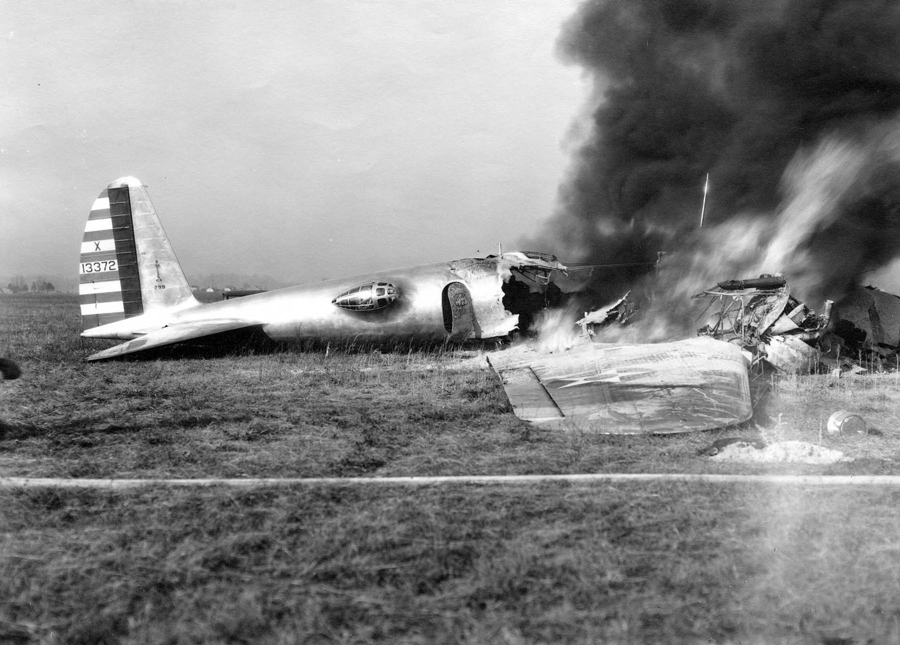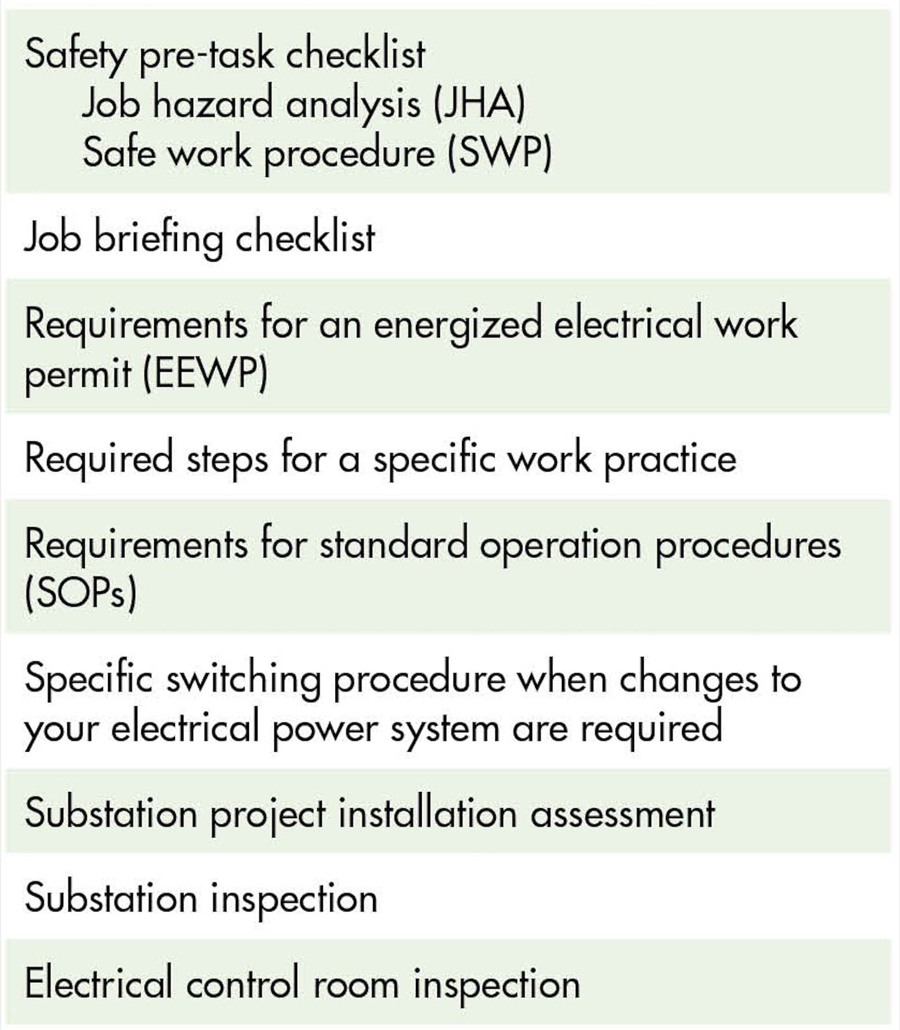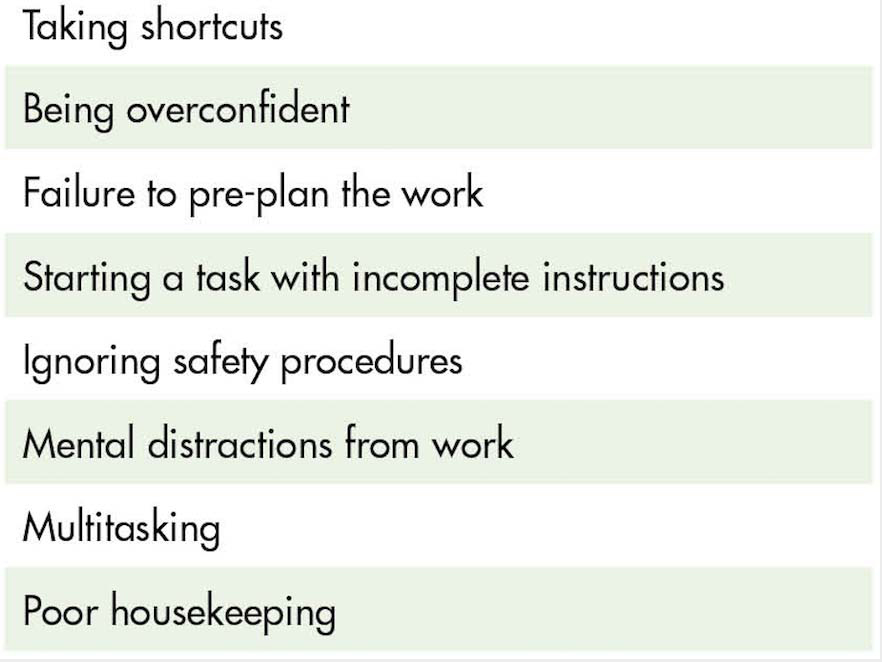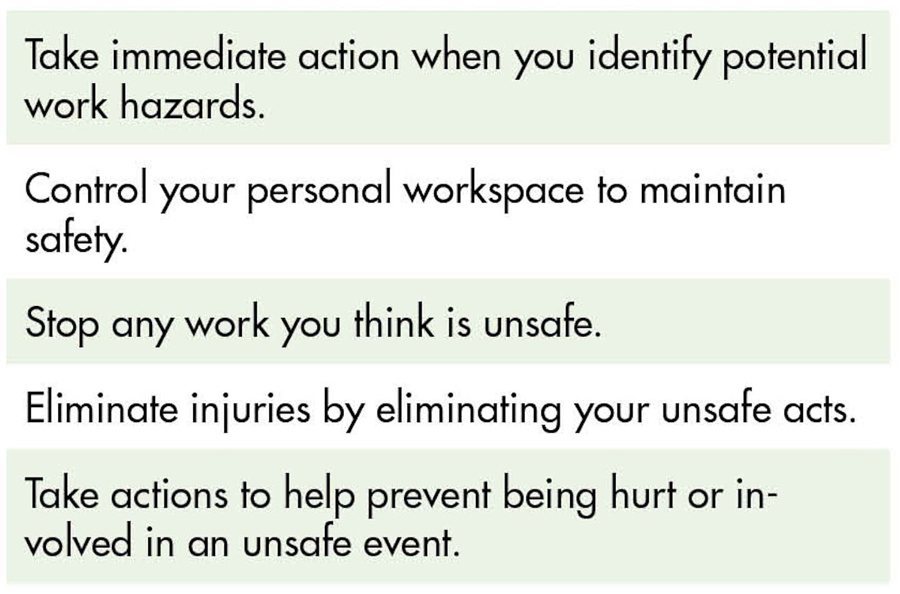“People who are trying to change
the world need to use checklists.”
BUSINESSMAN AND AUTHOR GUY KAWASAKI
Checklists and effective job briefings are important to ensure hazards that may exist when performing a task are addressed before starting the job. In addition, job briefings are important to ensure people understand their job roles and have a chance to speak up and recommend additional safer work practices and make sure an action plan exists if things go wrong. Job safety planning, job briefings, and the use of checklists before starting a task are important to help prevent incidents and fatalities from happening. People make mistakes. The use of job briefings and checklists before the start of a job will help minimize the possibility of human error when tasks are performed.[1][2]
CHECKLISTS IMPROVE HUMAN PERFORMANCE
“A checklist cannot fly a plane. Instead,
they provide reminders of only the most
critical and important steps.”
SURGEON AND AUTHOR ATUL GAWANDE
On October 30, 1935, an experimental bomber known as the Flying Fortress (B-17) crashed shortly after takeoff during a military demonstration for the U.S. Army Air Corps at Wright Airfield in Dayton, Ohio.
The cause of the incident was a pre-flight failure to remove the gust locks that prevent damage to the control surfaces of the airplane while on the ground. The failure of the pilots to complete this step before takeoff meant they had no ability to control the plane once it became airborne.[3]

Figure 1: B-17 Crash During Demonstration for U.S. Army Air Corps
CHECKLISTS CREATE ERROR-FREE SYSTEMS
Surviving pilots brainstormed how to prevent the pre-flight requirements from ever being missed again. The action taken by the investigation team was to mandate the use of a checklist that included pre-takeoff action items for a pilot’s review.[4]
People can and do make mistakes, and the use of checklists can prevent incidents from happening. Checklists are a functional, consistent method of combating human errors before they occur. Checklists can be adapted for use in a wide range of environments.
Aviation Checklists
Current Federal Aviation Regulations (FARs)[5] mandate checklist use that “must be designed so that flight crew members will not rely upon memory for items to be checked.” Today, you can’t take off or land in a commercial airplane without a mandatory checklist being used by pilots.
Checklists work to prevent an incident from happening if a critical step does not pass the requirements included in the checklist. Has your flight ever been delayed or cancelled due to items in the checklist not meeting all requirements? If this did occur, were you glad that a checklist was required before the flight was allowed to takeoff?
NASA uses checklists for launching rockets into space. Many launches have been cancelled due to failure to meet the steps required in the checklist. Checklists are widely used in the aircraft industry and the U.S. Navy Submarine Service, in critical maintenance facilities and hospital operating rooms, and during the commissioning of electrical projects. Use checklists to prevent incidents from happening or to minimize the results when unexpected events occur.
Surgical Checklists
Using checklists in hospitals during surgery has been proven to prevent infections. Since 2008, bloodstream infections have decreased by 44%, and surgical site infections have decreased by 20%. Using checklists before and during surgery has also cut complications by 35% and deaths by 47%.[6] When catheters are installed, the use of checklists has cut the infection rate from 4% of cases to zero, saving 1,500 lives and nearly $200 million.[7]
Just OK Is Not OK
Training is not enough to ensure incidents will not happen. When checklists are not used, the most experienced and qualified people may make mistakes.
Use checklists in your workplace. A good checklist is precise, efficient, and easy to use even in the most difficult situations. Checklists not only offer the possibility of verification, but also instill a discipline of higher performance. Checklists can help ensure people follow the required safety steps every time they perform a specific task.
Checklists have proven to work best in organizations that have a culture of safety supported by organizational leaders who prioritize safety in the workplace.[8]
USE CHECKLISTS FOR ELECTRICAL TASKS
“No matter how expert you may be, well-
designed checklists can improve outcomes.”
AUTHOR AND ECONOMIST STEVEN LEVITT
Checklists have been proven to add safety for personnel who perform electrical tasks.[9] They can help prevent mistakes and omissions during many electrical tasks. Checklists are a proven method to help prevent qualified people from skipping critical steps when completing tasks. The use of checklists should be mandatory when step-by-step procedures are required for safety.
Many mistakes have been prevented and lives saved by the use of checklists that ensured steps were not missed when tasks were performed.

Table 1: Types of Electrical Checklists
IMPROVE HUMAN PERFORMANCE BY ACTIVATING YOUR LEADERSHIP
“Teamwork is the fuel that allows common
people to attain uncommon results.”
INDUSTRIALIST ANDREW CARNEGIE
Job safety planning, job briefings, and checklists help prevent injuries and fatalities from happening. They provide the opportunity to think about and agree on the safe work practices and PPE requirements to use for the task to eliminate or minimize the risk to an acceptable level prior to starting the job.[10][11]
Effective job briefings and a review of existing checklists requires discussion and communication. Ask open-ended questions and get answers. Ensure everyone involved in the task participates during the job briefing and reviews the items included in the checklist. Consider what might not be included in the existing checklist. A best practice to improve safety is to visit the job site before work starts to look for hazards in the area that you may not have considered.[12] Examples include an energized overhead power line that exists in the area where work is to take place or additional people performing other tasks in the area where you will be working.
Consider the possibility of language barriers when job briefings are held. During construction and other jobs, some people may not understand what is being discussed. Use an interpreter to resolve the issue.

Table 2: Items that Cause Incidents to Occur
An effective job briefing should cover at least the following topics:
- Hazards associated with the job
- Work procedures involved
- Special precautions, language issues
- Energy source controls
- Personal protective equipment (PPE) requirements[13][14]
During the job briefing make sure everyone answers the following questions:
- Do I thoroughly understand the job?
- Do I understand my role and everyone else’s role in the job?
- Am I aware of all the hazards I may possibly encounter during the job?
- Am I knowledgeable of all safety rules and procedures applicable to this job?
- Do I have safeguards in place to protect me from unexpected events?

Table 3: Actions You Can Take to Improve Safety
REINFORCING THE SAFETY CULTURE IN YOUR ORGANIZATION
“Safety has to be everyone’s responsibility.
Everyone needs to know that they are
empowered to speak up if there’s an issue.”
NASA ASTRONAUT CAPTAIN SCOTT KELLY (RET.)
Make safety the number one priority in your facility or company. Mandate job briefings that include checklists before the start of jobs. The job briefing should include shock risk assessments and arc flash risk assessments.
Unsafe work practices cause 91% of incidents and injuries. In addition to the personal pain of suffering an injury, incidents can result in lost time, medical costs, equipment damage, production loss, and legal costs. The risk assessment procedure is designed to address the potential for human error and its negative consequences on people, processes, and the work environment.
Shock Risk Assessment
The first choice in a shock risk assessment is to eliminate the likelihood of occurrence of injury. Determine whether additional protective measures are required. For example, wear rubber insulating gloves with leather protectors and use insulating tools rated for the voltage you could encounter if you accidentally make contact with exposed energized electrical conductors or circuit parts.
Arc Flash Risk Assessment
During the arc flash risk assessment, consider the following issues:
- Design of the equipment as well as its overcurrent protective devices and operating times
- Electrical equipment operating condition and maintenance
- Appropriate safety-related work practices and PPE required for people within the arc flash boundary
CONCLUSION
“Job briefings and checklists are the
most high-powered productive tools ever
discovered.”
AUTHOR AND SPEAKER BRIAN TRACY
An important feature in an electrical safety program is the use of job briefings that include checklists. Reinforcing important steps in safe work practices through the use of job briefings that include checklists will reduce incidents and save lives. Ensure that job briefings include shock as well as arc flash risk assessments..
Improve safety in your facility by including these six steps:
- Create a culture that makes safety the number one priority.
- Improve actions taken by management to continually improve safety.
- Ensure that positive peer pressure to do the right thing exists in your facility.
- Monitor actions taken by workers to ensure they follow the safe work practices outlined in your safety program and training.
- Provide a good balance between leading as well as lagging indicators in your safety program.
- Perform a shock risk assessment and an arc-flash risk assessment before starting work.
Using these steps will help drive the company toward becoming an incident-free workplace.
REFERENCES
[1] Crow, Daryld Ray. “Checklists Save Lives,” 2020 IEEE IAS Electrical Safety Workshop (ESW2020-08), March 2020.
[2] Crow, Daryld Ray. “Effective Job Briefings Improve Safety,” 2021 IEEE IAS Electrical Safety Workshop (ESW2021-13), March 2021.
[3] “From the Ashes of the Model-299.” Accessed at www.thisdayinaviation.com/30-october-1935.
[4] “What the B17 Taught Us About Checklists.” Accessed at What the B17 Taught Us About Checklists – Angle of Attack (flyaoamedia.com).
[5] Code of Federal Regulations. Accessed at eCFR :: 14 CFR 431.39 — Mission rules, procedures, contingency plans, and checklists.
[6] “Habitual Excellence in the Workplace According to Paul O’Neill,” Pittsburgh Post-Gazette. Accessed at ‘Habitual excellence’: The Workplace According to Paul O’Neill | Pittsburgh Post-Gazette. May 13, 2012.
[7] Higgins, W.Y., and D.J. Boorman. “An Analysis of the Effectiveness of Checklists When Combined With Other Processes, Methods, and Tools to Reduce Risk in High Hazard Activities,” Boeing Technical Journal 2016.
[8] Haynes A., Gawande A. “A Surgical Safety Checklist to Reduce Morbidity and Mortality in a Global Population,” New England Journal of Medicine 360(5)491-499 (January 2009). Doi:10.1056/NEJMas0810119.PMID19144931.
[9] Gawande, Atul. The Checklist Manifesto. Picador, New York, 2009 ISBN 978-0-312-43000-9.
[10] National Fire Protection Association. NFPA 70E, Standard for Electrical Safety in the Workplace.
[11] Occupational Safety and Health Administration. OSHA 29 CFR Subpart R 1910.269, Electric Power Generation, Transmission, and Distribution.
[12] Forck, Mathew. “Four Key Steps to Conducting an Effective Job Briefing,” T&D World, July 1, 2019.
[13] Hanford Mission Support Contract. “Conducting Pre-Task Job Briefings and Post-Job Briefings,” April 28, 2011.
[14] Setcorret, LLC. WP0001-2015,
Job Briefings. Accessed at JobBriefingsWorkPracticeExample.pdf (setcorrect.com).
 Daryld Ray Crow is presently Owner and Principal Technical Consultant for DRC Consulting Inc., where he performs consulting work for electrical safe work practice standards, assessments/audits, electrical safe work practice training, and electrical engineering projects. Ray graduated from the University of Houston with a BSEE. After graduation, he worked for Alcoa providing global engineering support on the design, installation, and operation of power and rectifier systems and electrical safety. Ray was a team leader for writing multiple Alcoa electrical standards including electrical safe work practice standards and training and was responsible for providing internal electrical safety audits of Alcoa facilities. After retiring from Alcoa, he worked for Fluor Global Services and Duke Energy as a Principal Technical Specialist providing design and consulting engineering for creating electrical safety standards for companies, and providing safe work practice training programs, assessments/audits of facilities, and plant power distribution systems. Ray is a Life Senior Member of IEEE, a principal member of the NFPA 70E Technical Committee, Secretary of IEEE Std. P1584.1, Technical Editor and Secretary of IEEE Std. P1814, Chair of PCIC Working Group IEEE Std. 463, and was Secretary of IEEE Std. 1584. In 2010, Ray received the IEEE/PCIC Electrical Safety Excellence Award; in 2017, he received the IEEE/ESW Outstanding Service Award. He has co-authored and presented technical papers and tutorials for a number of IEEE IAS PCIC conferences, IEEE IAS Pulp & Paper conferences, IEEE IAS Electrical Safety Workshop conferences, and NETA’s PowerTest conference.
Daryld Ray Crow is presently Owner and Principal Technical Consultant for DRC Consulting Inc., where he performs consulting work for electrical safe work practice standards, assessments/audits, electrical safe work practice training, and electrical engineering projects. Ray graduated from the University of Houston with a BSEE. After graduation, he worked for Alcoa providing global engineering support on the design, installation, and operation of power and rectifier systems and electrical safety. Ray was a team leader for writing multiple Alcoa electrical standards including electrical safe work practice standards and training and was responsible for providing internal electrical safety audits of Alcoa facilities. After retiring from Alcoa, he worked for Fluor Global Services and Duke Energy as a Principal Technical Specialist providing design and consulting engineering for creating electrical safety standards for companies, and providing safe work practice training programs, assessments/audits of facilities, and plant power distribution systems. Ray is a Life Senior Member of IEEE, a principal member of the NFPA 70E Technical Committee, Secretary of IEEE Std. P1584.1, Technical Editor and Secretary of IEEE Std. P1814, Chair of PCIC Working Group IEEE Std. 463, and was Secretary of IEEE Std. 1584. In 2010, Ray received the IEEE/PCIC Electrical Safety Excellence Award; in 2017, he received the IEEE/ESW Outstanding Service Award. He has co-authored and presented technical papers and tutorials for a number of IEEE IAS PCIC conferences, IEEE IAS Pulp & Paper conferences, IEEE IAS Electrical Safety Workshop conferences, and NETA’s PowerTest conference.
